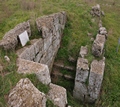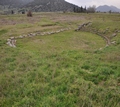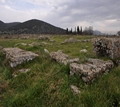
The ancient city of Mantineia was founded in Arcadia. Today's visitor approaches the ancient city via the provincial road that leads from Tripoli to the communities of Artemisiou and Orchomenou, at a distance of about 13 km north of the prefecture's capital. Mantineia is one of the important cities of antiquity in terms of size, shape and preservation. As the mythical founder of the city, Pausanias mentions Mantineus, grandson of the progenitor of the Arcadians Pelasgus, to whom the transition of Mantineia from the tribal structure to the state organization is attributed. With its strategically important geographical position, Mantinea emerged early on as the theater of important historical events connected not only with the local Arcadian history but also with important developments in the Greek area during antiquity.
The enlightening text of the traveler of the 2nd c. m.X. Pausanias in combination with other written sources as well as the excavation data, constitute the set of elements that help us today to trace the route of Mantinea through the centuries.
The administrative center of Mantinea during the prehistoric era is considered to be the hill of Gortsuli a short distance north of the surviving city of classical times, to which modern research identifies the Ptolin of the written sources. The route of Mantinea during historical times is more clearly known. In the plain that extends approximately 13 km north of Tripoli, it was founded, probably at the beginning of the 5th century. BC, one of the two important cities of eastern Arcadia - the other being Tegea -, as a product of the settlement of five rural communities in the region.
The constant competition between Mantinea and Sparta for control and dominance in the wider area resulted in the destruction of the older Mantinea by the king of Sparta Agisipolis in 385 BC, with a trick that Xenophon mentions thoroughly in Greek 5 ,2,1-7. The Mantineans left the city and dispersed again in comas. This administration of Mantinea lasted until 370 BC, when, on the initiative of the Theban general Epaminondas, the city was re-established in the same position, in order to be a bulwark against the Spartan expansion towards the north. A few years later, in 362 BC, the great Theban soldier was to die in the territory of Mantineia, during military operations.
The varied historical route of Mantinea does not stop here. During the Hellenistic era, the city had initially joined the Achaean commonwealth. However, the efforts of the alliance of the Aetolians and the Lacedaemonians and the extermination by the Mantineans of the Achaean garrison established in the city, had dramatic consequences for the Mantineans: in 223 BC. the Macedonian king Antigonus III together with his Achaean allies captured the city, killed the most prominent Mantineans, deposed others and plundered Mantineia. 221 BC the city is repopulated, which is now called Antigoneia, ironically projecting the Macedonian king Antigonus as the inhabitant of the city. The name Antigone was preserved for the city until the first decades of the 2nd century AD, when the emperor Hadrian visited it and restored its original name. The Roman emperor established in Mantinea a cult in honor of the dead favorite of Antinous, whose native land, Bithynium in Asia Minor, was considered a Mantinean colony of Arcadia.
The traveler Pausanias visited the area around 170 AD. and refers in detail to the history and monuments of Mantineia (8, 4-9, 10). In the itinerary of the European travelers E. Dodwell and W. Gell, who followed Pausanias' route centuries later, the first evidence of the then surviving monuments of ancient Mantineia is presented.
Between the years 1887-1889, the first excavations were carried out in the area of the ancient market by a research group of the French School of Archeology under the direction of G. Fougeres. From 1960 onwards, small-scale rescue excavations by the Archaeological Service brought to light building remains of the city as well as a temple building on Gortsuli hill.
Mantineia is mainly known for the impressive remains of its fortified enclosure as well as its market, with its theater and imposing public buildings, which occupied the center of the ancient city, a short distance east of the modern church of Agia Fotini.
In ancient times, Mantineia occupied an extensive plain of eastern Arcadia and was surrounded by mountains and hills that formed the natural boundaries of its territory from Orchomenos to the north and Tegea to the south.
The visitor can start his tour of the archaeological site from the Gortsouli hill, which is located at a distance of about 1 km north of Mantineia. Gortsouli is identified with the prehistoric acropolis of ancient Mantineia, called by Pausanias Ptoli. From the top of the hill, where the recently renovated Naydrium of the Virgin Mary is also located, one can admire the panoramic view of the entire Mantine plain and distinguish the fortified enclosure of the ancient city that stands like a ring in its middle. On the western slope of the hill, which shows a sharp descent, the shovel of the Archaeological Service, under the direction of Theodora Karagiorgas, brought to light a temple of archaic times, which shows two building phases.
As the visitor takes the road back from Gortsouli to Mantineia, he sees, on either side of the provincial road, parts of the strong fortification wall that enclosed the ancient city in a total area of 1.24 square kilometers. Continuing south, one reaches the walled market area of Mantineia, easily accessible from the country road leading to Tripoli. The first monument that the visitor encounters during his tour of the site is the theater, which was formed by an artificial embankment and occupied the western end of the market area. The market, rectangular in plan, in its final configuration during imperial times was particularly imposing with impressive entrances, arcades that surrounded it on three sides and many paved streets that crossed its interior free space.
From this monumental ensemble, partially revealed by the French excavations of the 19th century, the visitor can today visit two temples a short distance south of the stage construction of the theater, which are attributed to the cult of Hera and Zeus, based on detailed description of Pausanias. The building that survives immediately north of the stage of the theater must have been built in honor of Mantinea Podareos. Finally, the large building that occupies the middle of the southern side of the market has been identified with the parliament of the ancient city.
Mantineia not only has sanctuaries, public buildings and imposing fortifications but also residences and burial monuments, which are currently well protected under the Mantinean earth. It has, above all, the rare privilege of not being destroyed or covered by newer settlements and of being in an eminently unspoiled Mediterranean environment.
Source: MINISTRY OF CULTURE AND SPORTS
odysseus.culture.gr









